Mount Vesuvius is a famous volcano of all time. It carries thousands of years of history along with it. It has been of main interest to both historians and geologists. For kids who are interested in volcanoes, learning about Mount Vesuvius is a must. We have gathered a complete set of Mount Vesuvius Facts For Kids which will enable the kids to learn all about Mount Vesuvius. We have tried to answer almost all the questions that might arise in your mind about this mountain.
Mount Vesuvius Facts For Kids
1. What is Mount Vesuvius
- Mount Vesuvius is an active volcano located in Campania, west of Italy.
- It is one of the companion volcanic arcs i.e active volcanoes.
- It has erupted more than 200 times. Some of the volcano eruptions were highly destructive.
- It is famous for the 79 A.D eruptions, which destroyed the Roman cities of Pompeii and Herculaneum.
- Mount Vesuvius is the most dangerous volcano in today’s world because of the nearby population.
- It is the only volcano that lies on the mainland of Europe and has erupted in the last hundred years.

2. Description of Mount Vesuvius
- Vesuvius is a convexly curved peak consisting of a large cone ‘Gran Cono’. A steep rim encircles the large cone.
- The height of the main cone does not remain constant. It varies with the eruptions.
- This structure of Mount Vesuvius is caused by the breakdown of the big Mount Somma.
- Mount Somma was the original and earlier structure of the present Mount Vesuvius.
- The 79 A.D eruptions of Mount Somma released more energy than the atomic bombs dropped in Hiroshima-Nagasaki.
3. Characteristics of Mount Vesuvius
- Mount Vesuvius is a volcano depression. It is circular.
- It is a volcano containing many minor and major volcano centers.
- The lava erupted by Mount Vesuvius is reddish yellow, emerging from under the ground.
- The temperature of the lava is about 1200 Degrees Celsius.
- The lava produced by Mount Vesuvius carries large rocks and blows them into the air.
- The lava flows very smoothly, which is uncommon in other volcanoes. This makes Mount Vesuvius very dangerous.
4. What Type Of Volcano Is Mount Vesuvius
- Mount Vesuvius can be classified as a Stratovolcano.
- It contains explosive eruptions, hot high-density lava, ash, and gases.
- Mount Vesuvius and some other Italian volcanoes make the Campanian volcanic arc.
5. How Big Is Mount Vesuvius
- A giant’s valley (Valle del Gigante) lies in between Mount Somma and Cone called Gran Cono.
- At the peak of the cone is a large hole of about 305 meters i.e. 1000 ft.
- This hole is about 610 meters i.e. 2000 ft deep.
- It has a circumference of about 12 km i.e. 7.45 miles
- The hole was formed as a result of the eruption of 1944.
- The distance around the base of Mount Vesuvius is about 30 miles i.e. 48.3 km.
6. How High Is Mount Vesuvius
- The height of Mount Vesuvius changes continuously with eruptions.
- In 2013, the height of the cone was found to be 1281 meters i.e. 4203 feet.
- A long narrow semicircular hilltop begins at about 600 meters i.e. 1968 feet, called Mount Somma.
- Towards the north, the cone is encircled by Mount Somma rising to about 1132 meters i.e. 3714 feet.
- This height is gained due to the eruptions of 1944.
7. How Old Is Mount Vesuvius Volcano
- Literary tradition makes Mount Vesuvius a very historic place.
- Scientists believe that the Vesuvius area was subjected to volcano activity about 400,000 years ago.
- The formation of the Volcano started about 25,000 years ago.
- The oldest known eruption is the 18,300 B.C eruption known as Basal Pumice eruptions.
- The Somma caldera was formed in the Basal Pumice eruptions.
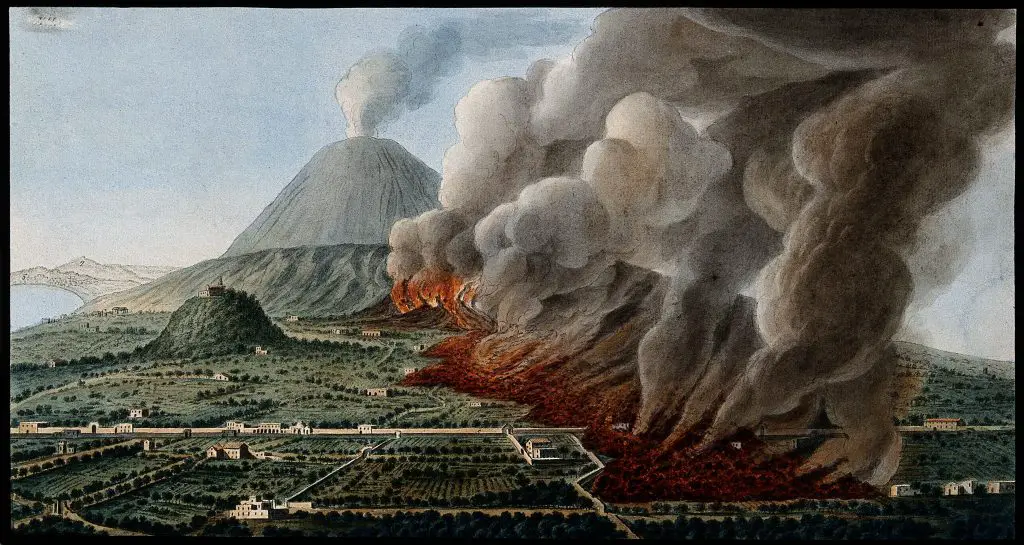
8. Mount Vesuvius Plate Boundary – Mount Vesuvius Tectonic Plates
- Vesuvius is a part of the Campanian volcanic arc.
- Tectonic plates boundary of Mount Vesuvius occurs where African Plate and the Eurasian plate come together.
- There is a tear in the African plate in Vesuvius. The Earth’s mantle layer melts the rock of the African plate which causes eruptions.
9. Where is Mount Vesuvius – Mount Vesuvius Location
- Mount Vesuvius is located in Campania, Italy.
- Campania lies to the west of Italy.
- It lies 9 km or 5.6 miles to the east of Naples, near the shore.
- The coordinates of Mount Vesuvius are 40°49′ N and 14°26′ E.
- It is the only active volcano in mainland Europe.
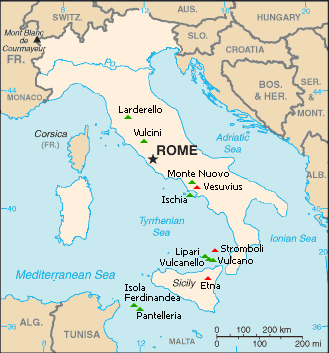
10. Effects of Mount Vesuvius
- The Vesuvius volcano has caused many earthquakes and tsunamis.
- It destroyed the city of Pompeii, damaging the neighboring cities too.
- The 79 A.D eruptions were so big that they hid the sun, and killed almost all the people living there.
- The eruptions affected all of Rome. Pompeii was an important city of Rome during the time of rebellions. The destruction ended the possible conflict between Rome and its provinces that caused rebellions.
- There were numerous small quakes after the major quake, and the quakes continued for several years.
- The soil near Mount Vesuvius is very fertile and hence people used to live nearby for agriculture purposes.
- Whenever the eruptions occurred, the inhabitants were greatly affected.
11. Who Discovered Mount Vesuvius
- The city of Pompeii was buried in ashes and rocks after the volcanic eruptions in 79 A.D. Nobody knew about the city until it was discovered by a survey engineer in 1748.
- The name of the survey engineer was Rocco Gioacchino de Alcubiere.
- He was sent by the King of Naples, Charles Bourbon on a mission to bring home ancient statues and treasures.
- Pompeii is the longest excavated archaeological site in the world.
- The only eyewitness of the 79 A.D. volcano is “Pliny the younger”, who described the volcano as a lamp that is lit in a dark room.
- His uncle “Pliny the elder” explained the situation to him, but couldn’t survive.
12. Mount Vesuvius History
- Mount Vesuvius has been an active volcano for a very long time.
- The original Somma caldera was formed 18,300 years ago.
- The lava eruptions after this formation were less violent.
- Mount Vesuvius might have erupted several times. Only some are known to us from inspection.
- There have been different volcano eruptions of different magnitudes 16,000 years; 11,000 years; 8000 years, and 5000 years ago.
- Avellino eruption occurred 3,800 years ago. It destroyed various settlements of the Bronze Age. The area is now covered by Naples.
- There were frequent but less violent ranges of eruptions.
- In 217 B.C, eruptions from Mount Vesuvius caused earthquakes in Italy. It is reported that the sun was dimmed and dark clouds spread across the sky.
- The volcano didn’t erupt for 295 years before the 79 A.D eruptions.
- Different gardens and vineyards were made in the area. Then the most violent eruption occurred in 79 A.D. known as the ‘Plinian eruption’.
- It destroyed the cities of Pompeii and Herculaneum.
- Smaller eruptions of lower magnitudes occurred at different times since 79 A.D.
- The latest eruption is the 1944 eruption during World War II.
- It destroyed several villages and a base camp of Allied forces.
13. How Was Mount Vesuvius Formed
- It is believed that Mount Vesuvius formed almost 200,000 years ago.
- Two tectonic plates i.e the African and the Eurasian collided.
- The Eurasian plate went deeply to the edge of the African plate.
- This pushed water from the African plate to hot regions that lie deep in the earth.
- As a result, the water boiled and melted the rocks because the melting point of the Eurasian plate dropped.
- The above process caused the formation of magma.
- The magma pushed upward as the surrounding rocks were denser than the magma and broke away from the earth at a weak spot i.e at Vesuvius. Hence, a volcano was formed.
14. Mount Vesuvius Eruption
- Most of Mount Vesuvius’ eruptions were small.
- Some of these eruptions threw small rocks and ashes in the nearer area, rarely damaging the population.
- Sometimes the eruptions were very dangerous; usually when they erupted after a long time.
- The most destructive eruptions of Mount Vesuvius are the 79 A.D. and 1944 A.D. eruptions.
- These eruptions occurred after a long time as compared to their normal eruption cycle.
- The Mount flushed out ashes, rocks, and boiling lava.
- The rocks fell on the buildings and people, destroying the buildings and killing the people.
- In 79 A.D, the cities of Pompeii and Herculaneum were destroyed by these eruptions.
- Similarly, in 1944 A.D., the eruptions destroyed five different towns that were near the base of Mount Vesuvius.
15. When Did Mount Vesuvius Erupt
- The last major eruption of Mount Vesuvius is the 1944 eruption.
- It started on 17th March 1944 during World War II.
- Rocks of the size of the basketballs, and ash rained from Mount Vesuvius.
- Then slow-moving hot flowing lava erupted from the Vesuvius.
- This continued for two weeks destroying everything coming in its path.
- It destroyed many villages and a US base camp.
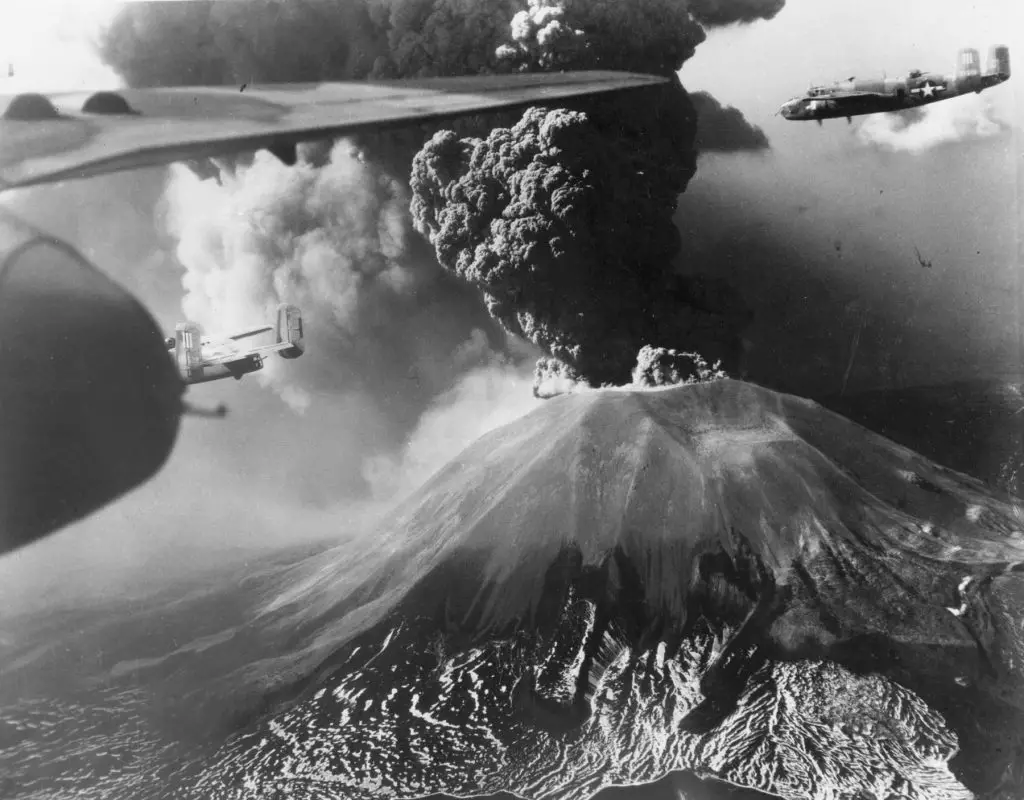
16. Mount Vesuvius Type Of Eruption
- The Volcano from Mount Vesuvius is categorized as a ‘complex stratovolcano’.
- The stratovolcano is the common type of volcano that exists on earth.
- It includes explosive eruptions and the flow of hot lava.
- The hot lava contains pumice and volcanic gas.
- This lava doesn’t spread very far from its origin.
- It cools and gets hard early due to high viscosity.
- This type of lava erupts from the very depths of the ground.
17. What Happened During The Eruption Of Mount Vesuvius
- Mount Vesuvius has erupted many times.
- The most important are the 79 A.D. eruptions and the latest 1944 eruptions.
- A survivor of the 79 A.D. eruptions was Pliny the Younger.
- He described the eruptions as a very high pine tree. The cloud went high and expanded in different branches, sometimes white and sometimes dark.
- In Pompeii, ash blocked the sun and the people tried to clear heavy ash from rooftops as it fell at a rate of about 6 inches (15 centimeters) an hour.
- The last eruptions from Mount Vesuvius were in March 1944 during World War II.
- It brought ground shaking, roaring, and rumbling. The sounds were like the bombing of artillery.
- It destroyed a US camp in Pompeii and everything else that came in its path.
- These eruptions also destroyed San Sebastiano al Vesuvio, Massa di Somma, Ottaviano, and part of San Giorgio a Cremano. These are villages near Pompeii.
18. When did Mount Vesuvius Erupt in Pompeii
- Pompeii was an administrative town full of business activities. It served as a passage for the goods to Rome.
- Mount Vesuvius has erupted several times but 79 A.D eruptions caused enormous destruction and destroyed the city of Pompeii.
- The eyewitness of the destruction was Pliny the younger.
- Almost 20,000 people were killed in the 79 A.D eruptions.
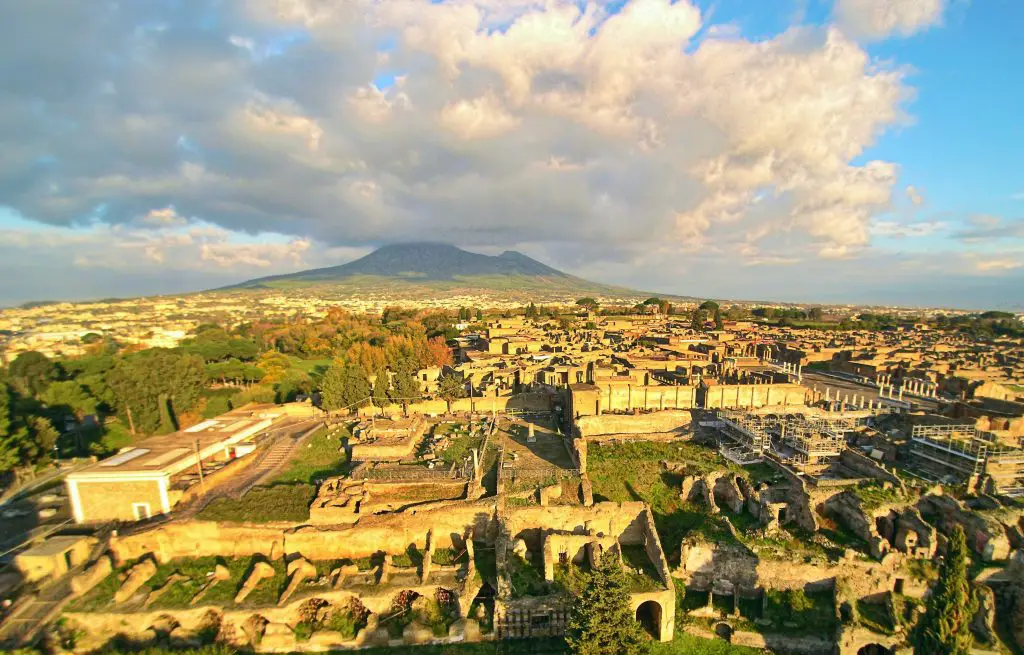
19. How Did Mount Vesuvius Erupt
- Mount Vesuvius has erupted several times but it is famous for the 79 A.D. eruptions.
- These eruptions were the most destructive in European history.
- They pushed a cloud of super-heated gases and rock fragments of random sizes and shapes to a height of about 33 km (21 miles).
- Molten rocks pumice and hot ashes were ejected at a rate of about 1.5 million tons per second.
- This rate is equal to 100,000 times the atomic explosions in Japan.
20. When Did Mount Vesuvius First Erupt
- Scientific research states that the area was subjected to volcanic activity for 400,000 years.
- The Volcano started to form 25,000 years ago.
- Then a series of lava flows, and smaller eruptions made way for big eruptions.
About 19,000 years ago, the small eruptions changed into large eruptions. - The eruptions are known as ‘Plinian eruptions’.
21. Mount Vesuvius Eruption 79 A.D.
- The 79 A.D. eruptions are considered the most destructive eruptions of Mount Vesuvius.
- It destroyed the flourishing cities of Pompeii and Herculaneum.
- The eruptions killed almost the whole population i.e more than 20,000.
- First, there was a rain of ashes on the area, pouring ashes of about 6 inches on roofs of buildings.
- Shortly after the ashes, the lava broke out from the Vesuvius.
- It destroyed the city of Herculaneum. People from Herculaneum ran towards Pompeii.
- The next morning, the fire flood flew towards Vesuvius, killing all the people coming in its way.
- The superheated air from the lava damaged the lungs of the people.
- The eruption also caused earthquakes in distant areas.
- Pliny the younger, who was an eyewitness of the destruction described the incident as the city was taken to darkness like the black, closed, and unlighted rooms.
- Even now the city of Pompeii contains the remains of buildings, skeletons, a layer of dust, and many well-preserved items in buried form.
22. Mount Vesuvius Eruption 1944
- Mount Vesuvius erupted on 17 March 1944 during World War II.
- This eruption lasted for two weeks.
- At Pompeii, the soldiers and airmen of Allied forces were camped a few miles away from the base of the volcano.
- Hot ashes and small rocks were rained from the sky. Soldiers wore leather jackets and helmets for protection. Their tents caught fire.
- Louder sounds of roaring, groaning could be heard after regular intervals of time.
- The eruptions from the Vesuvius made the land very fertile.
- The whole mountain was on fire as the lava flowed down the mountain.
- The lava traveled a distance of about 1 mile. It was half a mile wide and 8 feet deep.
- Thick dark clouds arose from the base of Vesuvius.
- The lava first destroyed the city of Naples. Then flowed above the mountains towards the base camp of Allied forces.
- The Allied forces were compelled to leave the camp. Many jet planes were damaged partially or wholly by the heated airwaves and lava.
- Villages of San Sebastiano al Vesuvio, Massa di Somma, Ottaviano, and part of San
- Giorgio a Cremano were destroyed as the lava flowed.
- The eruptions killed 26 civilians and displaced 12000 people from their homes.
23. Why did Mount Vesuvius Erupt – What Caused Mount Vesuvius To Erupt
- Scientific study reveals a tear in the African plate.
- The heat from Earth’s mantle layer reached the rocks in the upper layer through this tear.
- The heat melted the rocks causing pressure.
- The pressure resulted in violent explosive eruptions.
- There had been an eruption cycle of about 20 years, but the last serious eruption occurred in 1944.
24. How Many Times Has Mount Vesuvius Erupted
- The Volcano has erupted six times during the 18th century.
- It erupted eight times in the 19th century.
- Mount Vesuvius has erupted more than 50 times after the 79 A.D. eruptions.
- The last eruption was the 1944 A.D. eruption.
- After 1944, the smoke has arisen from Vesuvius, alarming the surrounding area, but it didn’t erupt till now.
25. What Year Did Mount Vesuvius Erupt – Mount Vesuvius Eruption Dates
- There occurred an eruption in 1800 B.C. known as the Avellino eruption which destroyed some Bronze Age settlements.
- The most famous eruption occurred in 79 A.D.
- Then it erupted in 172, 203, 222 A.D.
- It also erupted in 303, 379, 472, 512, 536, 985, 787 A.D.
- It erupted around 860, 900, 968, 991, 999, 1006, 1037, 1049, 1073, 1139, 1150 A.D.
- There had been eruptions in 1270, 1347, and 1500 A.D.
- It erupted almost six times in the 18th century including 1779 and 1794 A.D.
- It erupted eight times in the 19th century. The 1872 A.D eruptions were notable.
- The Volcano erupted in 1906, 1929, and 1944.
- There have been no eruptions since 1944.
26. How Often Does Mount Vesuvius Erupt
- The Mount Vesuvius eruption period has varied from 6 months to 30.7 years.
- There has been a still period ranging from 3 years to 7.5 years.
- Whenever a long still period occurs, it is often an indication of a huge eruption.
27. How Many People Died When Mount Vesuvius Erupted
- Mount Vesuvius has killed hundreds and thousands of people because a large population always lived near the base of Vesuvius.
- It has destroyed many cities and villages.
- The total number of deaths is unclear however it has killed more than 20,000 people.
- More than 3000 people were killed in the eruptions that occurred in 1631.
- It killed more than 100 people in the 1906 eruptions.
- More than 20,000 people died in 79 A.D eruptions.
- Even now skeletal remains of the people are buried in the city of Pompeii.
28. When Will Mount Vesuvius Erupt – Mount Vesuvius Next Eruption
- It is not possible to predict when Mount Vesuvius might erupt again.
- As per observations, the volcanologists say that magma is developing, and gradually rising.
- They predict huge eruptions this time.
- The eruptions might be of the order of the 79 A.D. eruptions that destroyed the cities of Pompeii and Herculaneum.
29. Is Mount Vesuvius Still Active
- Vesuvius is still considered an active volcano.
- It has erupted more than 30 times since 79 A.D.
- It is believed that Mount Vesuvius has a cycle. At the end of the cycle, it erupts.
- The eruptions that occurred in 1913-1944 were the end of the cycle that started in 1631.
30. What Happened To The City Of Pompeii
- Before 79 A.D., Pompeii was a city full of lights.
- Administratively, it was a very important city for Rome.
- Its strategic location made it very important for Rome as all the trade was carried out to/from Rome through Pompeii.
- In 79 A.D., certain small and gradually bigger earthquakes jolted Pompeii city.
- The inhabitants didn’t take any action and considered it a usual phenomenon.
- In August, 79 A.D. Mount Vesuvius threw dust to a few miles of the base area. The ashes reached the town of Stabia.
- The roofs of the houses were filled with dust.
- People were cleaning their houses from the dust when it flushed rocks and very hot molten lava.
- The rocks and lava killed almost all the people living in Pompeii.
- Pliny the Elder, who survived the eruptions saw huge clouds emanating from the Vesuvius. On August 24, he dispatched several ships to investigate the matter but the ships were drowned because the rocks destroyed them.
- The eruptions destroyed the town of Herculaneum as well.
- Almost 20,000 people were killed by these intense eruptions in 25 hours of period.
31. Interesting Facts About Mount Vesuvius
- Mount Vesuvius is the only active volcano that lies on mainland Europe.
- There are two peaks in the region called Mount Vesuvius and Mount Somma.
- Mount Vesuvius had not erupted in 1800 years before the 79 A.D. eruptions.
- People of Pompeii and Herculaneum didn’t know that Mount Vesuvius is a volcano.
- Farming was a major source of income for the people in 79 A.D., and Mount Vesuvius was very fertile for growing gardens.
- The remains of the city of Pompeii were not discovered until 1748 AD.
- 2.6 Million People visit Mount Vesuvius and remain in Pompeii every year.
- Mount Vesuvius has not erupted since 1944, and scientists expect huge eruptions this time.
- Today more than 600,000 people live in the red zone area near Mount Vesuvius, and the authorities are planning to evacuate the area from the people.
- Visitors are not allowed within 200 meters of the summit point.
- The area has been declared as a national park on June 5, 1995, and opened for visitors.
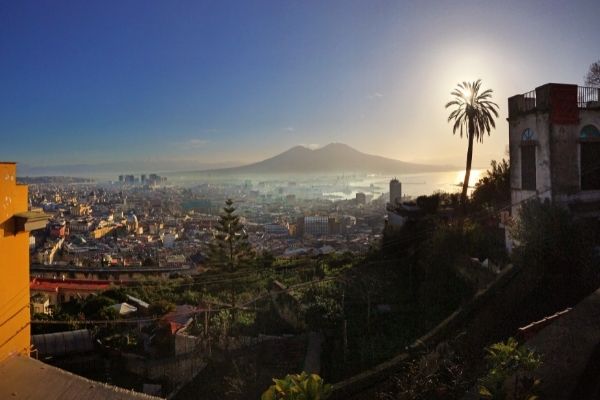

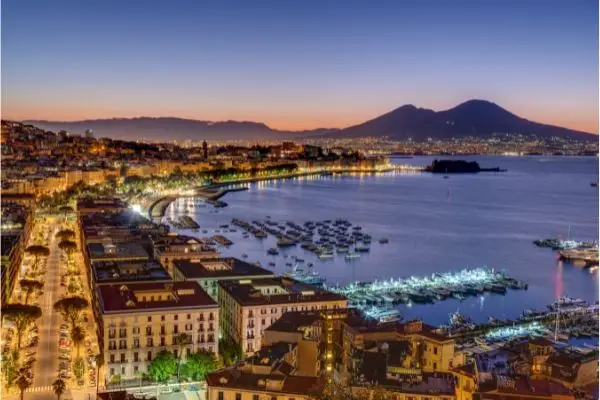



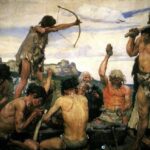




This is very good for children.
Interesting. yes
very kid friendly!
Thank you so much. I could tell you put so much effort
fine
thank you for the help super much
this is nice
good job
who is just comenting lol
dis cool
I like this guy named hunter
i love the corila his AAAAAAAAAAAAAA
thank you for the info
this is nice
Thank you sooo much! It helped that all he questions were there so I didn’t have to read through the whole thing to find
what I was looking for.
There were no jet planes during World War II
Hi I’m a potato ???
I love this website.